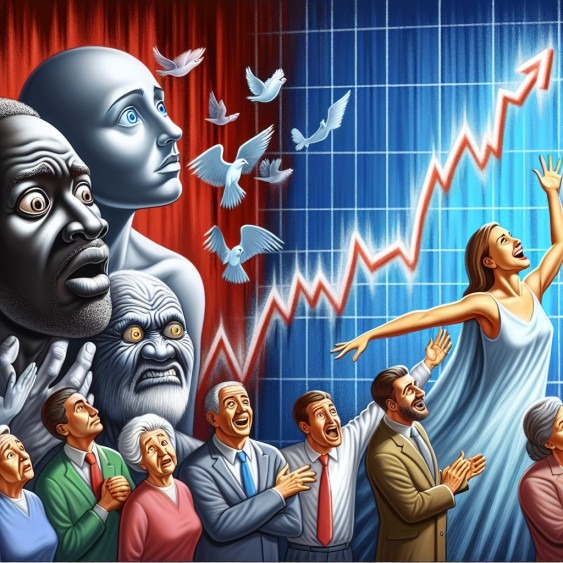US Stock Market Fear and Greed Index: Embrace Fear, Reject Joy
May 14, 2024
In the fast-paced world of stock trading, investors constantly seek tools and indicators to help them make more informed decisions. One such tool that has gained prominence recently is the Stock Market Fear and Greed Index. This essay will delve into the index’s intricacies, its historical significance, and the insights provided by top behavioural psychologists and experts on crowd behaviour.
Historical Significance of the Fear and Greed Index
Historically, the index has been a contrarian signal, suggesting buying opportunities when fear is high and caution when greed prevails. For instance, during the 2008 financial crisis, the index indicated extreme anxiety, which, in hindsight, was a good buying opportunity. Conversely, during the Dotcom bubble, high greed levels were a warning sign of the impending market correction.
While the Fear and Greed Index can be helpful, it should be used alongside other analyses, such as fundamental and technical analysis, to make informed investment decisions. It’s important to remember that the index reflects sentiment and not necessarily market fundamentals.
Decoding the Stock Market Fear and Greed Index
The Fear and Greed Index is a comprehensive gauge of the stock market’s emotional climate, ranging from 0 (intense fear) to 100 (intense greed). This index draws insights from various market indicators, each shedding light on different facets of market sentiment. Let’s break down the key elements:
Stock Price Momentum:
This factor assesses the S&P 500 concerning its 125-day moving average. If the S&P 500 is above this average, it signals a market driven by greed, pushing prices higher. Conversely, if it’s below, fear might prompt a market pullback.
Market Volatility:
Typically measured by the CBOE Volatility Index (VIX), this aspect mirrors the market’s anticipation of short-term fluctuations. A high VIX indicates heightened fear, while a low VIX implies complacency or greed.
Historical instances, like the elevated greed levels during the Dotcom bubble or the intense fear during the 2008 financial crisis, demonstrate how the index can potentially signal market shifts. However, for a well-rounded investment strategy, it’s crucial to integrate the Fear and Greed Index with other analyses.
Put and Call Options
The put/call ratio is a critical component of the Fear and Greed Index, providing insights into investor sentiment. Put options grant the right to sell an asset at a predetermined price, while call options enable the holder to buy an asset. A high put/call ratio indicates that investors are buying more puts than calls, suggesting a bearish market sentiment and a preparation for potential downturns. Conversely, a low put/call ratio suggests a bullish outlook, with investors betting on the market’s upward movement.
A historical example of this in action is the 2008 financial crisis. As the crisis unfolded, the put/call ratio spiked, indicating a high level of fear as investors sought protection against further market declines. Conversely, during the bull market of 2013, the put/call ratio was relatively low, suggesting a high level of market optimism and potentially excessive greed.
Market Sentiment: Breadth and Safe Haven Demand
Market sentiment is crucial to understanding investor behaviour and market trends. Two key indicators of market sentiment are market breadth and safe-haven demand. By analyzing these factors, investors can gain valuable insights into the market’s overall health and make informed decisions.
Market Breadth:
Market breadth measures the number of stocks advancing versus declining. It provides a comprehensive view of market participation and can signal potential trend changes.
During the late 1990s tech bubble, market breadth narrowed as fewer stocks hit new highs despite the rising Nasdaq index. This divergence was a warning sign of an unhealthy market.
In the recovery of the 2008-2009 financial crisis, broadening market breadth indicated a return to market health and the start of a new bull market.
A study by Ned Davis Research found that when more than 60% of stocks are above their 50-day moving average, the S&P 500 has a 91% chance of being higher a year later.
Safe Haven Demand:
Investors seek safe-haven assets like gold and government bonds during market uncertainty and fear.
Gold, a traditional haven, often sees increased demand during market downturns. In 2020, gold prices reached record highs as investors sought protection from the economic impact of the COVID-19 pandemic.
Government bonds, considered low-risk investments, experience higher demand during market fear. This flight to safety leads to higher bond prices and lower yields.
– A study by the National Bureau of Economic Research found that during the 2008 financial crisis, the 10-year Treasury yield fell from 3.7% to 2.1% as investors fled to the safety of government bonds.
Insights from Legendary Investors
Warren Buffett, one of the most successful investors of all time, emphasizes the importance of market sentiment in his investment strategy.
Buffett famously advised, “Be fearful when others are greedy, and greedy when others are fearful.” This contrarian approach has been a key factor in his success.
During the 2008 financial crisis, Buffett invested $5 billion in Goldman Sachs, recognizing an opportunity amidst market fear.
Benjamin Graham, the father of value investing, also stressed the significance of market sentiment.
Graham’s “Mr. Market” analogy portrays the market as an emotional entity that fluctuates between optimism and pessimism. He advised investors to take advantage of market fear by purchasing undervalued assets.
In his book “The Intelligent Investor,” Graham wrote, “The investor’s chief problem – and even his worst enemy – is likely to be himself.” This highlights the importance of controlling emotions and avoiding the pitfalls of market sentiment.
Interpreting Fear and Greed Index Values
Understanding the numerical values of the Fear and Greed Index is essential for making informed investment decisions. Let’s break down what each range of values typically signifies:
Extreme Fear (0-25): When the index hovers in this range, it suggests a high level of fear among investors. This could indicate a potential buying opportunity, as market sentiment may be overly pessimistic.
Fear (26-50): Values in this range still suggest a degree of fear, but not at an extreme level. Investors might be cautious, but opportunities for those willing to take calculated risks may exist.
Greed (51-75): A Fear and Greed Index reading in this range indicates a more optimistic market sentiment. Investors may be more willing to take risks, and markets could be overvalued.
Extreme Greed (76-100): Extreme greed prevails at the upper end of the scale. While this may seem optimistic, it could also indicate that the market is due for a correction as investors become excessively bullish.
Contrarian Investing: Navigating Market Fear
Contrarian investing is a strategy that goes against prevailing market sentiment. It involves buying when others are selling and selling when others are buying. Key points:
The Stock Market Fear Index (VIX) measures market volatility and investor fear. Contrarians view high fear as a buying opportunity.
During the 2008 financial crisis, contrarian investor Howard Marks bought undervalued assets amidst market pessimism, employing a “buy low, sell high” approach.
In the late 1990s Dotcom bubble, Warren Buffett avoided overvalued tech stocks, demonstrating contrarian risk management. His caution paid off when the bubble burst.
Legendary economist John Maynard Keynes emphasized a long-term perspective, noting that short-term fear-driven fluctuations are temporary.
Benjamin Graham, the father of value investing, focused on intrinsic value over market price. His philosophy of “Price is what you pay, value is what you get” is a contrarian cornerstone.
Real examples:
The S&P 500 fell 57% from 2007 to 2009. Contrarian investors who bought during this fear-driven decline saw significant gains in the following years.
– In 1999, the Dotcom bubble saw the Nasdaq Composite Index rise over 500% in 5 years. When it crashed, the index lost 78% of its value, validating Buffett’s contrarian avoidance of tech stocks.
– Research by Harvard Professor David Laibson found that individuals who sold stocks during the 2008 crisis missed out on the subsequent rebound, underperforming those who held through the decline.
The contrarian approach capitalizes on market inefficiencies caused by irrational fear. By evaluating market conditions objectively and maintaining a long-term focus, contrarians position themselves to profit from mispriced assets. This strategy requires discipline and a willingness to go against the crowd, but history shows its effectiveness in navigating turbulent markets.
Market Sentiment vs. Fundamentals
It’s essential to recognize that the Fear and Greed Index measures market sentiment, which can often deviate from the stock market’s fundamental realities. Investors should use the index as a complementary tool alongside fundamental analysis to make well-rounded investment decisions.
Various factors, including news events, geopolitical developments, and economic indicators, can influence market sentiment. Therefore, it’s crucial to consider the broader context in which the Fear and Greed Index operates.
Recent Historical Trends
To better understand the Fear and Greed Index’s utility, let’s examine some historical trends and notable events that have affected market sentiment:
Global Financial Crisis (2008): During the 2008 financial crisis, the Fear and Greed Index reached extreme fear levels, reflecting the deep-seated anxiety in the market.
COVID-19 Pandemic (2020): The onset of the pandemic led to another period of extreme fear, causing a significant market downturn. Investors sought safety, and the index accurately reflected this sentiment.
Bull Markets: The Fear and Greed Index tends to hover in greed territory during extended bull markets. This can serve as a warning signal, as markets may become overextended, potentially leading to a market downturn. This is because over-optimism can result in overpricing, making the market vulnerable to sudden corrections when the actual value of stocks becomes apparent.
Earnings Season: Quarterly earnings reports can also impact the index, with better-than-expected results typically fueling investor optimism. Conversely, disappointing earnings can trigger fear, leading to sell-offs. For example, in 2018, a series of disappointing earnings reports from major tech companies like Facebook and Netflix led to a significant drop in the index, indicating rising fear in the market.
Conclusion
The Stock Market Fear and Greed Index is a valuable tool for investors looking to gauge market sentiment and make informed investment decisions. By understanding its components and interpreting its values, investors can use the index to navigate the ever-changing landscape of the stock market. However, it’s crucial to remember that market sentiment should be considered alongside fundamental analysis, as sentiment can sometimes deviate from the underlying economic realities. With the Fear and Greed Index as part of their toolkit, investors can approach the stock market more confidently and clearly.
In stock trading, staying ahead of the curve is crucial. The Fear and Greed Index gives investors a unique insight into the emotional undercurrents driving the stock market. By learning to interpret this index, investors can make more informed decisions, adjust their portfolios, and take advantage of market sentiment trends. Whether you’re a seasoned investor or just starting, the Stock Market Fear and Greed Index can be valuable to your investment strategy.
To truly embrace the wisdom of fear and reject the pitfalls of joy, investors must understand the emotional landscape of the market. Only then can they make decisions not solely based on the cold, hard facts of the market but also on the emotional tides that pull it in various directions. The Fear and Greed Index is an indispensable tool in this endeavour, illuminating the often murky waters of market sentiment.
Other Articles of Interest

Is Inflation Bad for the Economy? Only if You Don’t Know the Truth

Contagion Theory: Unleashing Market Mayhem Through Panic

What is the Minsky Moment? How to Capitalize on It

Dunning-Kruger Effect Graph: How the Incompetent Overestimate Their Skills

Schrödinger’s Portfolio: Harness It to Outperform the Crowd

Allegory of the Cave PDF: Unveiling Plato’s Timeless Insights

What is Relative Strength in Investing? Unleash Market Savvy

Dow 30 Stocks: Spot the Trend and Win Big

Out-of-the-Box Thinking: Be Wise, Ditch the Crowd

Stock Market Psychology Chart: Mastering Market Emotions

Stock Market Forecast for Next 3 Months: Trends to Watch, Predictions to Ignore

Lone Wolf Mentality: The Ultimate Investor’s Edge

Copper Market News: Distilling Long-Term Patterns

Unleashing the Power of Small Dogs Of the Dow

Inductive vs Deductive Analysis: The Clash of Perspectives



